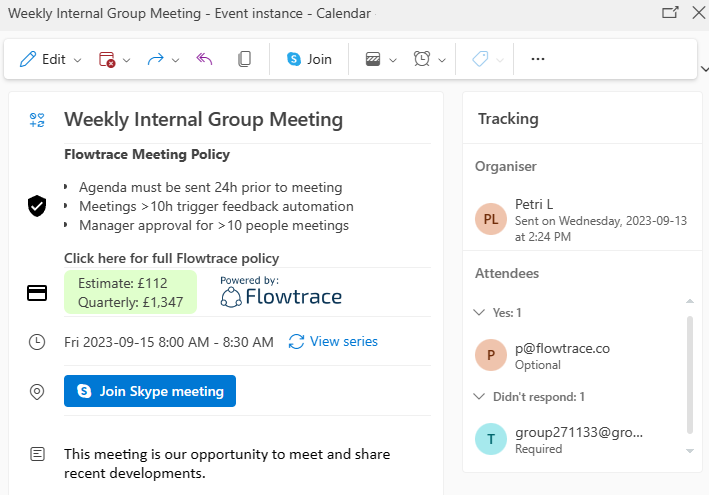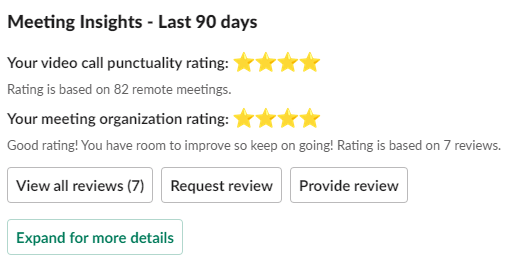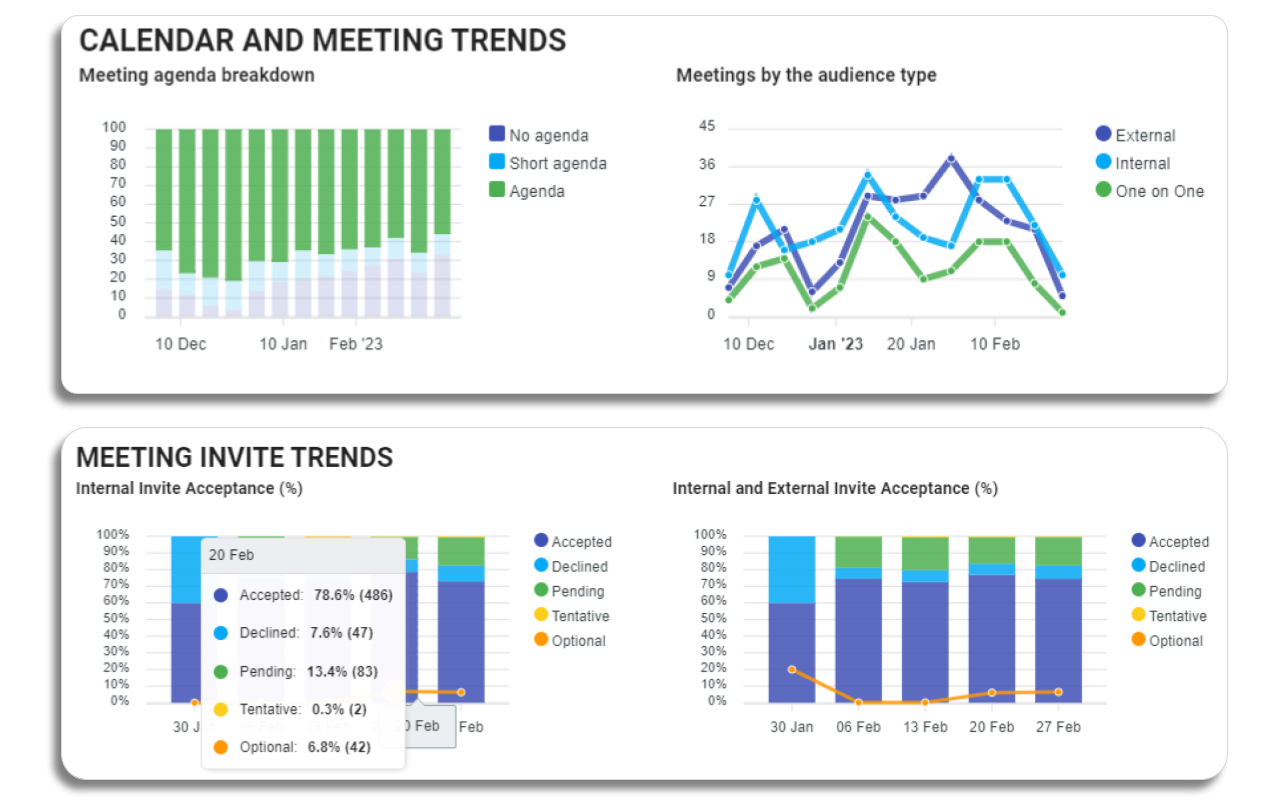Calendar Analytics For Outlook
Improve time management & meeting organization with calendar analytics for Outlook. Get insights into meeting culture, enhancing productivity &...
Learn how managers can reduce meetings to improve productivity and employee satisfaction. Discover strategies and tools for effective meeting management.
In the current work environment, meeting overload has become a pressing concern for many companies. Excessive meetings can lead to decreased productivity and employee burnout. Recognizing and addressing this issue is crucial for maintaining a healthy, efficient work environment. This article explores strategies companies can employ to reduce meetings, emphasizing the critical role of efficient meeting management in fostering a productive organizational culture.
The current meeting landscape in many organizations is characterized by an overload that can significantly impact both productivity and employee morale. A common issue is the 'meeting for the sake of meeting' culture, where the default response to any problem or update is to schedule a meeting. For example, a survey by HBR found that 64% of senior managers said meetings come at the expense of deep thinking. This can lead to a packed schedule with little time for focused, independent work.
Employees may find themselves in back-to-back meetings, many of which may not require their input or could have been resolved through a simple email or quick chat. The result is a noticeable decrease in actual productive work hours and a potential increase in overtime as employees try to complete their tasks outside of these meetings.
Furthermore, excessive meetings can drain employee morale. The feeling of spending hours in meetings, often discussing the same points repeatedly or not reaching a decisive conclusion, can be incredibly frustrating. It can lead to a sense of stagnation, where employees feel their time and skills are not being utilized effectively. This dissatisfaction can manifest in decreased engagement, lower job satisfaction, and even increased turnover rates.
The impact on productivity is significant. Research and surveys consistently show that an excessive number of meetings can lead to a substantial dip in productivity, with employees feeling they have less time to accomplish their actual work. This not only affects individual performance but can also have a ripple effect on the team and organizational goals.
There's also the cost, for example, a study on productivity by Bain & Company, found that a weekly meeting of mid-level managers at a large manufacturing company cost more than $15 million each year.
The current landscape of meetings in many organizations is marked by an excessive number that often leads to reduced productivity and poor employee morale. Understanding these issues is critical for any company looking to improve its meeting culture and overall efficiency.
Establishing a clear meeting policy is a critical step for companies aiming to reduce excessive meetings and enhance productivity. The process involves a series of strategic decisions and consultations to determine what an effective meeting looks like within the organization.

Firstly, it's essential to define the purpose of meetings. This involves identifying which types of discussions genuinely warrant a meeting and which can be handled through other communication channels. Clear criteria help in deciding when to schedule a meeting and when to opt for an email, memo, or quick call.
The next step is setting guidelines on meeting frequency. This includes establishing rules on how often different types of meetings should occur. For instance, daily stand-ups might be brief and focused, while strategic planning meetings could be less frequent but longer. These guidelines help prevent meeting overload and ensure that each meeting is necessary and adds value.
Duration is another crucial aspect. Long, drawn-out meetings can be counterproductive. Setting a standard duration for different meeting types encourages participants to be concise and focused. For example, setting a 30-minute cap on routine update meetings can prompt attendees to stick to the agenda and avoid unnecessary tangents.
Participant inclusion is equally important. The policy should guide who needs to be in each meeting type. Inviting only those who are directly involved or have a significant contribution ensures that discussions are relevant and decisions are expedited. Overcrowding meetings with unnecessary attendees can dilute the conversation and reduce overall effectiveness.
Defining a clear meeting policy is about creating a culture where meetings are purposeful, efficient, and productive. This approach respects everyone's time, enhances focus, and contributes to a more dynamic and effective work environment. Companies that successfully implement and adhere to a well-defined meeting policy can expect to see significant improvements in productivity and employee satisfaction.

Cutting down on meetings is a crucial step in enhancing workplace efficiency. A strategic approach involves identifying and eliminating unnecessary meetings, prioritizing essential discussions, and utilizing alternative communication methods.
Firstly, review existing meetings to identify which are essential. This involves analyzing the purpose, outcomes, and participant engagement of each meeting. Meetings that consistently fail to yield meaningful outcomes or engage participants effectively are prime candidates for elimination.
Prioritizing meetings is another key strategy. Not all meetings are of equal importance. Prioritize meetings that align with your team's key goals and objectives, and be open to postponing or canceling those of lesser importance.
Using alternative communication methods can effectively reduce the need for many meetings. Quick updates, for instance, can be communicated via email, team messaging apps, or through project management tools. These platforms often provide a more efficient way to disseminate information without taking up valuable time in formal meetings.
By scrutinizing the necessity of each meeting, prioritizing essential discussions, and leveraging alternative communication channels, companies can significantly reduce the number of unnecessary meetings. This leads to more focused use of time, greater productivity, and a more satisfied workforce.
This process begins with a robust system for monitoring the implementation of new meeting practices. Regular reviews of meeting patterns, frequency, and participant feedback help in assessing the effectiveness of the new policies. This monitoring should be both quantitative, such as tracking the number of meetings held and their duration, and qualitative, involving gathering feedback from employees about their experiences and satisfaction with the meetings.
Feedback is essential for continual improvement. It provides insights into how well the new policies are being received and where adjustments may be necessary. Encouraging employees to share their thoughts on the meeting process, what works, and what doesn't, fosters a culture of openness and continuous improvement. This feedback can be collected through surveys, suggestion boxes, or informal discussions.

Reinforcing the new meeting practices within the organization requires consistent and clear communication. Managers should regularly remind teams of the meeting policies and the rationale behind them. Highlighting the benefits observed since implementing the new policies, such as increased productivity, better time management, or improved work-life balance, can help in solidifying these changes.
Recognizing and rewarding teams and individuals who effectively adhere to the new meeting guidelines can also reinforce positive changes. This could be through acknowledging their efficiency in meetings during performance reviews or sharing success stories across the organization to serve as examples.
The role of observing and reinforcing the message is crucial in sustaining the changes made to meeting policies. Through careful monitoring, open feedback channels, consistent communication, and positive reinforcement, organizations can ensure that their efforts to streamline meetings and enhance productivity are successful and long-lasting.

Flowtrace's analytics allow for deep insights into meeting patterns, revealing key areas where efficiency can be enhanced. By analyzing data such as meeting frequency, duration, and participant engagement, managers gain a clear understanding of how meetings are currently being conducted and where improvements can be made.
Our platform tools are instrumental in supporting the implementation and monitoring of meeting policies. The platform provides detailed reports that help managers assess the effectiveness of their meeting strategies. For example, by tracking changes in meeting frequency and duration over time, managers can gauge the success of new policies aimed at reducing unnecessary meetings.
Also, our tools offers feedback mechanisms that are crucial for continuous improvement. These tools enable participants to give immediate feedback on meetings, providing valuable insights into what is working and what is not. This feedback can then be used to make iterative improvements to meeting formats, agendas, and participant lists.
Additionally, Flowtrace’s cost calculators and other metrics offer a quantifiable view of the impact of meetings on organizational productivity. Managers can use these insights to make data-driven decisions about how to structure meetings to maximize efficiency and effectiveness.
Flowtrace provides a solution for optimizing meeting time and improving meeting culture. Its analytics, feedback mechanisms, and cost calculators work together to give managers a comprehensive view of their meeting landscape. By leveraging these tools, organizations can transform their meetings into productive, efficient, and purposeful engagements that contribute positively to their goals.
Reducing meetings and optimizing their efficiency is crucial for enhancing organizational productivity. Adopting strategic approaches and leveraging analytics from Flowtrace can significantly improve meeting management, leading to a more focused, engaged, and productive workforce. Organizations are encouraged to embrace these practices and technologies to foster a culture of efficiency and continuous improvement.
Improve time management & meeting organization with calendar analytics for Outlook. Get insights into meeting culture, enhancing productivity &...
Explore cost-saving strategies for meetings, including conducting calendar audits, understanding meeting culture, implementing meeting analytics...
Optimize your team's meeting efficiency and productivity with Flowtrace's Google Calendar analytics, transforming calendar data into actionable...